Roedl_Microsoft_Dynamics_CRM_R__2011-_2015_WCF_Adapter_for_BizTalk_Server_R__
- 格式:pdf
- 大小:2.28 MB
- 文档页数:57

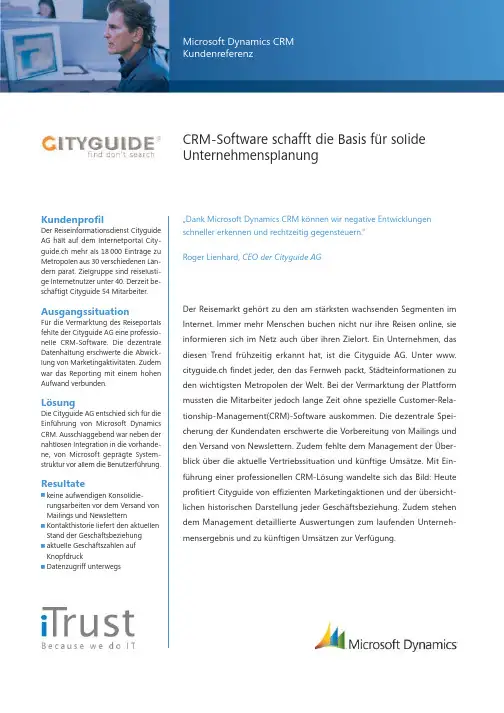
…Dank Microsoft Dynamics CRM können wir negative Entwicklungen schneller erkennen und rechtzeitig gegensteuern.“Roger Lienhard,CEO der Cityguide AGDer Reisemarkt gehört zu den am stärksten wachsenden Segmenten im Internet. Immer mehr Menschen buchen nicht nur ihre Reisen online, sie informieren sich im Netz auch über ihren Zielort. Ein Unternehmen, das diesen Trend frühzeitig erkannt hat, ist die Cityguide AG. Unter www.cityguide.ch findet jeder, den das Fernweh packt, Städteinformationen zu den wichtigsten Metropolen der Welt. Bei der Vermarktung der Plattform mussten die Mitarbeiter jedoch lange Zeit ohne spezielle Customer-Rela-tionship-Management(CRM)-Software auskommen. Die dezentrale Spei-cherung der Kundendaten erschwerte die Vorbereitung von Mailings und den Versand von Newslettern. Zudem fehlte dem Management der Über-blick über die aktuelle Vertriebssituation und künftige Umsätze. Mit Ein-führung einer professionellen CRM-Lösung wandelte sich das Bild: Heute profitiert Cityguide von effizienten Marketingaktionen und der übersicht-lichen historischen Darstellung jeder Geschäftsbeziehung. Zudem stehen dem Management detaillierte Auswertungen zum laufenden Unterneh-mensergebnis und zu künftigen Umsätzen zur Verfügung.KundenprofilDer Reiseinformationsdienst Cityguide AG hält auf dem Internetportal City-guide.ch mehr als 18000 Einträge zu Metropolen aus 30 verschiedenen Län-dern parat. Zielgruppe sind reiselusti-ge Internetnutzer unter 40. Derzeit be-schäftigt Cityguide 54 Mitarbeiter.AusgangssituationFür die Vermarktung des Reiseportals fehlte der Cityguide AG eine professio-nelle CRM-Software. Die dezentrale Datenhaltung erschwerte die Abwick-lung von Marketingaktivitäten. Zudem war das Reporting mit einem hohen Aufwand verbunden.LösungDie Cityguide AG entschied sich für die Einführung von Microsoft Dynamics CRM. Ausschlaggebend war neben der nahtlosen Integration in die vorhande-ne, von Microsoft geprägte System-struktur vor allem die Benutzerführung.Resultatekeine aufwendigen Konsolidie-rungsarbeiten vor dem Versand von Mailings und NewsletternKontakthistorie liefert den aktuellen Stand der Geschäftsbeziehung aktuelle Geschäftszahlen auf KnopfdruckDatenzugriff unterwegsCRM-Software schafft die Basis für solideUnternehmensplanungKundenprofilDer Tourismus gehört zu jenen Branchen, die das Internet in den letzten Jahren gehörig ver-ändert haben. Immer mehr Menschen nutzen das Web, um Reiseziele auszuwählen und ihren Urlaub zu buchen. Ein Trend, den die Cityguide AG frühzeitig erkannt hat. Seit drei Jahren ist der Reiseinformationsdienst mit dem Portal Cityguide.ch am Markt präsent. Interessierte Besucher finden hier Städteinformationen zu Metropolen in über 30 Ländern. Mehr als 18000 Tipps zu Gastronomie, Shopping, Nacht-leben oder den lokalen Sehenswürdigkeiten haben die Autoren zusammengetragen. …Egal, in welche Stadt die Reise geht, bei uns findet man immer die passenden Informationen“, bringt Roger Lienhard, CEO der Cityguide AG, die Vorteile des globalen Reiseportals auf den Punkt. Das sieht die Internetgemeinde offen-sichtlich genauso: Mehr als drei Millionen Nut-zer erreicht die Cityguide AG mit ihrem Infor-mationsangebot. Die höchsten Zugriffsraten werden dabei in den Ferienzeiten verzeichnet. Der Erfolg des Konzepts spiegelt sich längst in den Organisationsstrukturen wider. Die Zahl der Mitarbeiter ist von anfangs fünf auf mitt-lerweile 54 gestiegen. Hinzu kommen zwei Niederlassungen in Bangkok und New York, die Reiseinformationen aus erster Hand liefern.AusgangssituationFinanziert wird Cityguide.ch vornehmlich über Anzeigen. Ein hart umkämpfter Markt, bei dem es nicht nur auf eine gute Organisation, sondern vor allem auf die richtige Kundenan-sprache ankommt. In beiden Bereichen muss-te die Cityguide AG lange Zeit ihr Improvisa-tionstalent unter Beweis stellen, denn die Do-kumentation der Kundenbeziehungen offen-barte mitunter Lücken. …Bei der Pflege und Verwaltung der Kundeninformationen haben wir unseren Vertriebsmitarbeitern bislang freie Hand gelassen“, erinnert sich Roger Lienhard. Die Folge: Jeder Mitarbeiter pflegte in Microsoft®Office Outlook®seine Kundenda-ten selbst. Die Qualität fiel dabei – je nach in-dividueller Ordnungsneigung – sehr unter-schiedlich aus. Bei zentralen Marketingaktio-nen, beispielsweise dem Versand von Mai-lings, musste der gesamte Adressbestand erst aufwendig konsolidiert werden. Ebenso pro-blematisch war die fehlende Transparenz der Kundendaten. …Wir hatten weder Einblick in die aktuelle Auftragslage, noch konnten wir Vertriebsprognosen schnell abrufen. Das er-schwert die Vertriebssteuerung natürlich“, ge-steht CEO Lienhard. Auch für die Mitarbeiter war es mitunter schwer, Geschäftsvorgänge zu rekonstruieren. Die Journalfunktion in Out-look arbeitete eher langsam und wurde allen-falls sporadisch gepflegt. Ende 2005 entschied sich Cityguide deshalb für die Einführung ei-ner professionellen CRM-Software.Bei der Marktsondierung standen zwei Fakto-ren im Mittelpunkt, die den Kandidatenkreis merklich verkleinerten: Zum einen hatte der Reiseinformationsdienst seine gesamte IT-Infrastruktur bei dem Hosting-Dienstleister Everywhere gemietet. …Everywhere setzt aus-schliesslich auf Microsoft Technologie. Wir suchten also eine CRM-Software, die exakt in das vorhandene Systemumfeld passt und sich zudem als Hosting-Lösung einsetzen lässt“, benennt Roger Lienhard eine der beiden zen-tralen Anforderungen. Der zweite kritische Aspekt waren die eigenen Mitarbeiter. Gerade im Vertrieb, fügt Lienhard hinzu, sei die Be-reitschaft, sich mit Prozessoptimierung und neuen Anwendungen zu beschäftigen, eher gering. Verständlich, dass sich die Cityguide AG nicht allzu weit von der gewohnten Ar-beitsumgebung in Microsoft Outlook entfer-nen wollte. Im Sommer 2006 fiel die Wahl nicht zuletzt deshalb auf Microsoft Dynamics CRM®. …Eine nahtlose Integration in das vor-handene Systemumfeld und eine Benutzer-führung, die mit Outlook über weite Strecken identisch ist. Kein Zweifel, Microsoft Dynamics CRM passte genau in unser Profil“, begründet Cityguide-Chef Lienhard die Entscheidung. Mindestens ebenso wichtig sei die Option ge-wesen, das Softwareprojekt schrittweise um-zusetzen. Schliesslich habe man wegen der dünnen Personaldecke niemanden für länge-re Zeit freistellen können. Auf Empfehlung des…Mit Microsoft Dynamics CRM hat sich die Qualität der Kunden-betreuung verbessert.“Roger Lienhard,CEO, Cityguide AGHosting-Dienstleisters Everywhere erhielt der Microsoft Partner iTrust AG den Zuschlag für die Implementierung.LösungDie eigentliche Herausforderung bei der Um-setzung des Projekts im Spätsommer 2006 lag weniger im technischen als vielmehr im zwischenmenschlichen Bereich. …Gerade bei CRM-Projekten ist es besonders wichtig, die Mitarbeiter ins Boot zu bekommen“, stellt Lienhard klar. Es waren vor allem die orga-nisatorischen Vorteile der einheitlichen Da-tenhaltung, die den Vertrieb am Ende über-zeugten. …Jeder Vertriebsmitarbeiter hat ein grosses Interesse daran, dass seine Kunden bei Marketingmassnahmen berücksichtigt werden. Schliesslich ist bei informierten Kunden die Abschlusswahrscheinlichkeit höher“, erklärt der CEO. Anders als bei der manuellen Kon-solidierung der Kundendaten sei es bei einem sauber gegliederten, zentralen Verzeichnis praktisch ausgeschlossen, dass jemand …durchs Raster“ fällt. Auf der anderen Seite verschwieg das Projektteam nicht die Tatsache, dass Microsoft Dynamics CRM mehr Licht in die Vertriebsaktivitäten bringt und damit eine Kontrolle erleichtert. …Das ist aber nur ein Nebenschauplatz. Unser Ziel war es, die Ar-beitsbedingungen des Vertriebs zu verbessern, um unsere Geschäftschancen besser auszu-schöpfen“, unterstreicht Lienhard. Bei der tech-nischen Umsetzung hielt sich der Aufwand in Grenzen. So waren lediglich kleinere Eingriffe erforderlich, um Microsoft Dynamics CRM an die Anforderungen der Cityguide AG anzu-passen. …Wir haben überflüssige Felder aus den Eingabemasken entfernt und einige Aufklapp-menüs eingefügt, um die Eingabe zu be-schleunigen und die Datenkonsistenz zu ge-währleisten“, erläutert der Cityguide-Chef. Ebenfalls hinzugekommen sind mehrere Auto-matisierungen. Beispielsweise werden in jedem Stadium des Verkaufszyklus automatisch Nachfassaktivitäten erstellt, sollten diese ver-gessen werden. …Sonst kann es schnell passie-ren, dass ein Interessent zwar erfasst, aber an-schliessend nicht angerufen wird“, betont Lien-hard. Um den Verkaufsprozess lückenlos zu dokumentieren, pflegte man nicht nur die Kun-dendaten, sondern auch den kompletten Leis-tungskatalog in Microsoft Dynamics CRM ein.ResultateSeit September 2006 arbeiten 17 Mitarbeiter aus den Bereichen Vertrieb, Marketing und Vi-Die Cityguide AG ist ein Reiseinforma-tionsdienst. Auf dem Internetportal Cityguide.ch gibt es mehr als18000 Einträge zu 30 Ländern. F o t o : C i t y g u i d e A Gdeoproduktion mit der neuen CRM-Software. Die Kundendaten werden dabei zunächst de-zentral auf den Notebooks erfasst und laufend mit der zentralen SQL-Datenbank auf dem ex-ternen Unternehmensserver abgeglichen. Ein Konzept, das es den Mitarbeitern erlaubt, auch unterwegs Daten offline zu erfassen oder ab-zurufen. …Mit Microsoft Dynamics CRM sind un-sere Geschäftsprozesse sicherer als vorher. Vor allem dank der lückenlosen Kontakthistorie hat sich die Qualität der Kundenbetreuung ent-scheidend verbessert“, freut sich der City-guide-Chef. Neue Mitarbeiter seien dadurch immer auf dem aktuellen Stand und könnten sofort ins Tagesgeschäft einsteigen. Nicht zu-letzt wegen der gestiegenen Datentransparenz erwartet Lienhard in Zukunft eine Verdopp-lung der Vertriebsleistung. …Wir können nega-tive Entwicklungen jetzt schneller erkennen und rechtzeitig gegensteuern“, benennt er den entscheidenden Vorteil von Microsoft Dynamics CRM aus Sicht des Managements.Kein Wunder, dass ein Schwerpunkt beim wei-teren Ausbau des Systems auf dem Vertriebs-controlling liegt. So soll das Berichtswesen um zusätzliche Reports, etwa zu Abschlussquoten oder verfeinerten Vertriebsprognosen, er-weitert werden. Auch ganz oben auf der Wunschliste steht die direkte Übergabe von Verkaufschancen an die Unternehmenssoft-ware Microsoft Dynamics NAV®. Damit würde die erneute Erfassung der einzelnen Positio-nen bei der Rechnungsstellung entfallen.PartnerprofilDas Produktportfolio des Microsoft Partners iTrust AG umfasst neben CRM-Lösungen auch allgemeine Infrastrukturprojekte sowie die Virtualisierung und Konsolidierung vorhande-ner Systemstrukturen. Im Raum der deutsch-sprachigen Schweiz erwirtschafteten die 20 Mitarbeiter des Systemhauses zuletzt einen Jahresumsatz von über vier Millionen Schwei-zer Franken.© 2007 Microsoft Corporation. Alle Rechte vorbehalten.Alle genannten Produktbezeichnungen sind entweder eingetra-gene Marken oder Marken der Microsoft Corporation in den USA und/oder in anderen Ländern. Namen und Produkte ande-rer Firmen können eingetragene Warenzeichen der jeweiligen Besitzer sein.Publiziert April 20075000-646-24 Yu 04/07Software and ServicesMicrosoft Dynamics CRM 3.0Microsoft Office 2003Microsoft SQL Server 2005Microsoft Windows Server 2003Microsoft Exchange Server 2003PartneriTrust AGWeitere Informationen Für weitere Informationen über Microsoft Produkte und Services kontaktieren Sie bitte die lokale Microsoft Niederlassung:Microsoft Schweiz GmbH Richtistrasse 3CH-8304 WallisellenTelefon: +41 848 22 44 88Fax: +41 434 56 44 44/switzerlandFür weitere Informationen zur beschriebenen Kundenreferenz kontaktieren Sie bitte:iTrust AGPatrick MüllerBirkenstrasse 47CH-6343 RotkreuzTelefon: +41 41 798 00 11Fax: +41 41 798 00 10E-Mail:************************* www.itrust.ch。
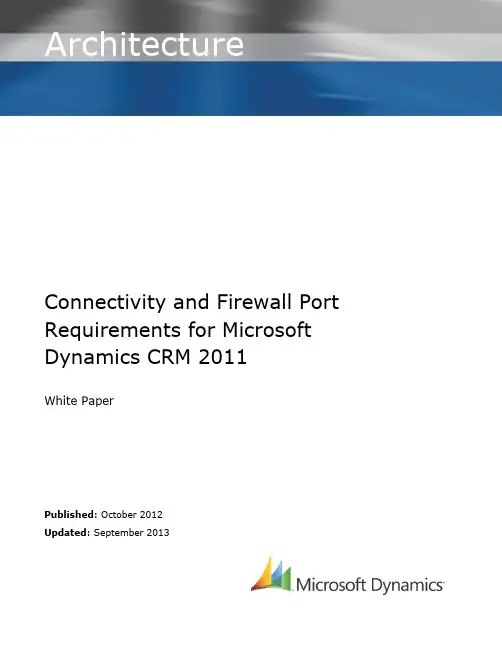
Connectivity and Firewall Port Requirements for Microsoft Dynamics CRM 2011White PaperPublished : October 2012 Updated : September 2013FeedbackTo send comments or suggestions about this document, please click the following link and type your feedback in the message body:/fwlink/?LinkID=267480Important: The subject-line information is used to route your feedback. If you remove or modify the subject line, we may be unable to process your feedback.2Table of ContentsOverview (4)On Premise with Integrated Windows Authentication (4)On Premise with Claims-Based Authentication (5)Default CRM Connectivity Requirements (6)Port Recommendations (8)Network ports for the Microsoft Dynamics CRM Web application (8)Network ports for the Asynchronous Service, Web Application Server, and Sandbox Processing Service server roles (9)Network ports that are used by the SQL Server that runs the Microsoft Dynamics CRM Reporting Extensions server roles (9)Connectivity Requirements for Windows Services (9)Connectivity Requirements for Integrated Windows Authentication (10)Mail Server Connectivity Requirements (11)Appendix A: Resources (12)3OverviewMany data centers include firewalls between the end users and the servers and other integrated systems that support an implementation of Microsoft Dynamics CRM 2011. This document is designed to provide guidance on the connectivity requirements between Microsoft Dynamics CRM 2011 and other systems to assist readers with proper firewall configuration in customer environments.On-Premises with Integrated Windows AuthenticationAn overview of an on-premises implementation that uses Integrated Windows Authentication (IWA) is shown in the following diagram.In this scenario the user must have a certain level of connectivity to the CRM Server(s), the Active Directory Server(s) and the SQL Server for SQL Filtered View access (if Export to Excel functionality is required). The remainder of this document focuses primarily on this scenario and details the required level of connectivity between these various components as well as further options for integration, Citrix implication, and so on.4On-Premises with Claims-Based AuthenticationAn overview of an on-premises implementation that uses claims-based authentication is shown in the following diagram using Active Directory Federation Service (ADFS) as the Security Token Service (STS).With claims-based authentication, the Microsoft Dynamics CRM site is accessed anonymously and is then redirected to ADFS. Users enter their credentials, which are validated by ADFS by contacting Active Directory Directory Services (AD-DS). Finally, AFDS issues a SAML token containing the necessary claims for accessing Microsoft Dynamics CRM.5Default CRM Connectivity RequirementsAn overview of the default connectivity requirements for an on-premises deployment ofIn addition all Servers require the following:∙ DNS name resolution on UDP/TCP: 53∙ NetBIOS name resolution on TCP: 139, UDP: 137/138∙ NTP time synchronisation: 123 –this is a requirement for Kerberos Authentication∙ DCOM and RPC: TCP 135, UDP 1025Note. Arrow direction depicts source and target of initiating request rather than direction of data flowImportant: Because this diagram is focused on Microsoft Dynamics CRM connectivity requirements, full details about the specific port requirements for Microsoft Exchange Server and the Microsoft Windows Active Directory service are not shown. Additional information and links to related articles about these technologies and their specific requirements are provided in the following sections of this document.6The default connectivity requirements for components of an on-premises deployment of Microsoft Dynamics CRM 2011 are shown in the following table.Important: In each case, the port numbers can be configured to run under alternative (non-default) values, so environments will vary.7Port RecommendationsNetwork ports for the Microsoft Dynamics CRM web application The following table lists the ports used for a server that is running a Full Server installation of Microsoft Dynamics CRM. Moreover, except for the Microsoft SQL Server role, and the Microsoft Dynamics CRM Connector for SQL Server Reporting Services server role, all server roles are installed on the same computer.Important: Depending on the domain trust configuration, additional network ports may be required for Microsoft Dynamics CRM to work correctly. For more detail, see Knowledge Base article ID 179442, How to configure a firewall for domains and trusts.8Network ports for the Asynchronous Service, Web Application Server, and Sandbox Processing Service server rolesThe following table lists the additional ports that are used for a deployment where the Sandbox Processing Service is running on a separate computer.Network ports that are used by the SQL Server that runs the Microsoft Dynamics CRM Reporting Extensions server rolesThe following table lists the ports that are used for a computer that is running SQL Server with only SQL Server and the Microsoft Dynamics CRM Reporting Extensions server roles installed.Note: The NETBIOS ports (TCP 139, UDP 137 and 138) are an alternative to port 445 which is used by SQL named pipes. These ports are required only during setup to determine the SQL port for named instances of SQL; the NETBIOS ports are not required during normal operation. Connectivity Requirements for Windows ServicesMicrosoft client, server, and server-based programs use a variety of network ports and protocols to communicate with client systems and with other server systems over the network. While beyond the scope of this article, details of the essential network ports, protocols and services that are used by Microsoft client and server operating systems, server-based programs, and their subcomponents in the Microsoft Windows server system are available on the Microsoft Support site in Article ID 832017, Service overview and network port requirements for Windows.9Connectivity Requirements for Integrated Windows AuthenticationThe key service and port requirements for Integrated Windows Authentication (IWA) are shown in the following table:However, in larger deployments, firewalls can present two challenges when deploying a distributed Active Directory (AD) directory service architecture:▪Initially promoting a server to a domain controller▪Replicating traffic between domain controllersActive Directory relies on remote procedure call (RPC) for replication between domain controllers. Note that while Simple Mail Transfer Protocol [SMTP] can be used in certain situations—schema, configuration, and global catalog replication—but not domain naming context, which limits its usefulness.Configuring replication in environments in which a directory forest is distributed among internal, perimeter networks and external (that is, Internet-facing) networks can be challenging. In these scenarios, there are three possible approaches:▪Open the firewall wide to permit the native dynamic behaviour of RPC▪Limit the use of TCP ports by RPC and open the firewall just a little bitNote: For additional detail about this option, see the following resources:∙Article ID 929851 - The default dynamic port range for TCP/IP has changed in Windows Vista and in Windows Server 2008∙Article ID 154596 - How to configure RPC dynamic port allocation to work with firewalls∙How to limit dynamic RPC ports used by DPM and protected servers▪Encapsulate domain controller (DC-to-DC) traffic inside IP Security Protocol (IPSec) and open the firewall for thatEach of these approaches has its pros and cons; in general, there are more cons than pros associated with the first option listed above and more pros than cons associated with the third option listed above.Note: For more information about each option, including details of the configuration and port requirements for each, see the TechNet article Active Directory Replication Over Firewalls.10Mail Server Connectivity RequirementsMicrosoft Dynamics CRM 2011 provides for integration with Exchange and other SMTP/POP3 servers. Mail system integration is typically achieved either through client-side integration via Outlook or server-side integration via Exchange or a third-party POP3/SMTP server.Note: This document focuses on server-side integration via Exchange, but the same principles would apply to server-side integration via other POP3/SMTP servers.Administrators can specify to use either client-side or server-side integration, which can be configured at a user level within the User properties in Microsoft Dynamics CRM. After the administrator specifies the level at which integration will occur, users on the client computers must agree to have email sent on their behalf by Microsoft Dynamics CRM by using their own user options configuration.While client-side integration does not require any additional server components, it works only with Microsoft Dynamics CRM for Outlook. The Microsoft Dynamics CRM for Outlook plug-in is then used to send email via Outlook and the users’ preconfigured mail Server as well as to route inbound emails back into Microsoft Dynamics CRM. This integration happens on a regular polling basis (but is not immediate). Additional Microsoft Dynamics CRM-specific ports are not required for this integration; standard Exchange connectivity is used. Emails are routed into Microsoft Dynamics CRM via the CRM Web Services; hence access to Port 80 (443 for SSL) from Microsoft Dynamics CRM for Outlook is the only requirement.The CRM Exchange Router can be installed on an Exchange Server or on a dedicated CRM Exchange Router server. Using the CRM Exchange Router provides inbound and outbound email connectivity for both the Microsoft Dynamics CRM web client and Microsoft Dynamics CRM for Outlook. This CRM Exchange Router integrates with external mail systems via:▪POP3 (TCP:110) and SMTP (TCP:25)▪HTTP-DAV (TCP:80) for the CRM Sink account or direct to users mail account▪Exchange Web Service (EWS) (TCP:80)11Appendix A: ResourcesFor additional information related to connectivity and firewall port requirements in Microsoft Dynamics CRM 2011, see the following additional resources:▪Microsoft Dynamics CRM 2011 Implementation Guideo Downloado View Online▪Service overview and network port requirements for Windows▪Article ID 929851 - The default dynamic port range for TCP/IP has changed in Windows Vista and in Windows Server 2008▪Article ID 154596 - How to configure RPC dynamic port allocation to work with firewalls ▪How to limit dynamic RPC ports used by DPM and protected servers▪Active Directory Replication Over Firewalls▪Securing Your Application Server12。
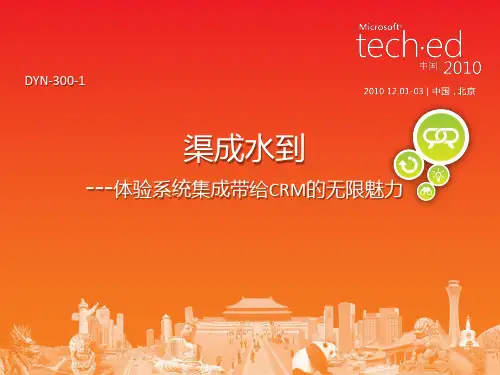
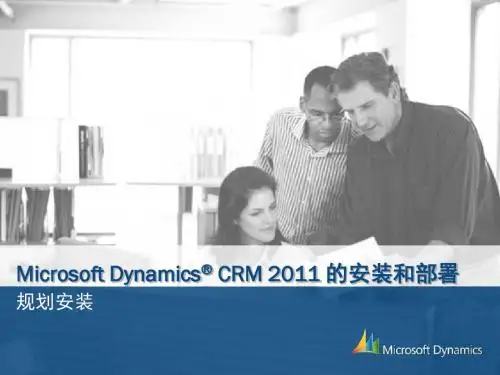
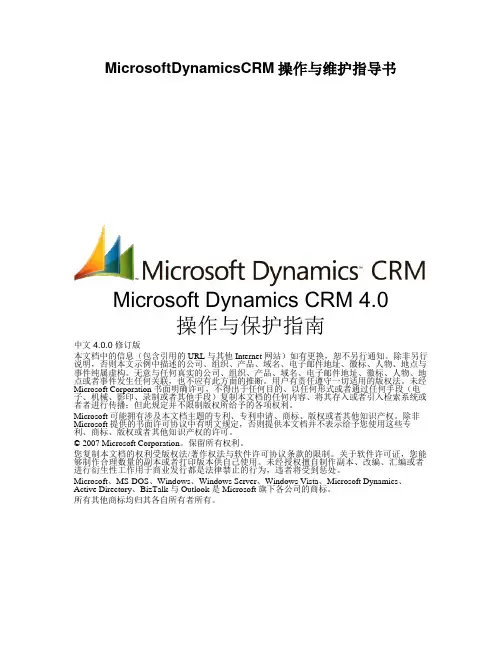
MicrosoftDynamicsCRM操作与维护指导书Microsoft Dynamics CRM 4.0操作与保护指南中文 4.0.0 修订版本文档中的信息(包含引用的 URL 与其他 Internet 网站)如有更换,恕不另行通知。
除非另行说明,否则本文示例中描述的公司、组织、产品、域名、电子邮件地址、徽标、人物、地点与事件纯属虚构。
无意与任何真实的公司、组织、产品、域名、电子邮件地址、徽标、人物、地点或者事件发生任何关联,也不应有此方面的推断。
用户有责任遵守一切适用的版权法。
未经Microsoft Corporation 书面明确许可,不得出于任何目的、以任何形式或者通过任何手段(电子、机械、影印、录制或者其他手段)复制本文档的任何内容、将其存入或者引入检索系统或者者进行传播;但此规定并不限制版权所给予的各项权利。
Microsoft 可能拥有涉及本文档主题的专利、专利申请、商标、版权或者其他知识产权。
除非Microsoft 提供的书面许可协议中有明文规定,否则提供本文档并不表示给予您使用这些专利、商标、版权或者其他知识产权的许可。
© 2007 Microsoft Corporation。
保留所有权利。
您复制本文档的权利受版权法/著作权法与软件许可协议条款的限制。
关于软件许可证,您能够制作合理数量的副本或者打印版本供自己使用。
未经授权擅自制作副本、改编、汇编或者进行衍生性工作用于商业发行都是法律禁止的行为,违者将受到惩处。
Microsoft、MS-DOS、Windows、Windows Server、Windows Vista、Microsoft Dynamics、Active Directory、BizTalk 与 Outlook 是 Microsoft 旗下各公司的商标。
所有其他商标均归其各自所有者所有。
目录1概述欢迎使用《Microsoft Dynamics CRM 4.0 操作与保护指南》,本指南是《Microsoft Dynamics CRM 4.0 实施指南》综合文档集的一部分。
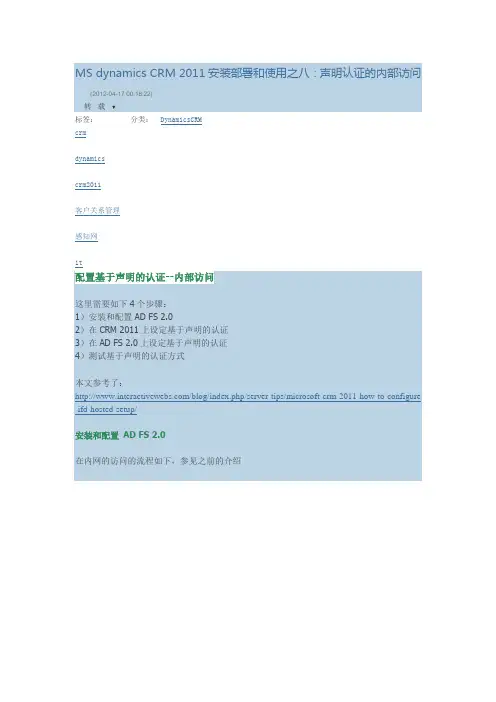
MS dynamics CRM 2011安装部署和使用之八:声明认证的内部访问(2012-04-17 00:18:22)转载▼分类:DynamicsCRM标签:crmdynamicscrm2011客户关系管理感知网it配置基于声明的认证--内部访问这里需要如下4个步骤:1)安装和配置AD FS 2.02)在CRM 2011上设定基于声明的认证3)在AD FS 2.0上设定基于声明的认证4)测试基于声明的认证方式本文参考了:/blog/index.php/server-tips/microsoft-crm-2011-how-to-configure -ifd-hosted-setup/安装和配置AD FS 2.0在内网的访问的流程如下,参见之前的介绍在这里AD FS 2.0负责向客户端发送token。
需要注意的是,AD FS 2.0默认必须安装到Default Web Site,CRM 2011安装在另外的站点,如下图。
如果不是这样,那你就要重新安装CRM 2011了。
下载AD FS 2.0 RTW/downloads/zh-cn/details.aspx?familyid=118c3588-9070-426a-b655-6c ec0a92c10b安装 AD FS 2.0在安装向导,选择“联合服务器”,确认安装完成。
完成时,勾选“启动AD FS 2.0管理单元”配置 AD FS 2.0AD FS 2.0管理界面,选择配置向导,选择“创建新的联合身份验证服务”,下一步选择”独立联合服务器“联合身份验证服务名称,输入。
说明:对于多个服务器的,可以设定为”"选择下一步直至完成安装验证AD FS 2.0工作打开IE, 输入联合元数据的URL地址https:///federationmetadata/2007-06/federationmetadata.xml说明:1)之外,其它URL部分是固定的2)对多个服务器的情况,这里的地址是对于弹出的警告,确认继续,此时IE会打开XML文件,表示AD FS 2.0工作正常在CRM 2011上配置基于声明的认证打开CRM部署管理器(开始--部署管理器)选择Dynamics CRM,右键,选择“属性”选择WEB地址,绑定类型,选择HTTPS,现在设置的地址是给内网访问的,我们设定一个域名“",端口是刚才设定CRM的SSL端口,446.确认。

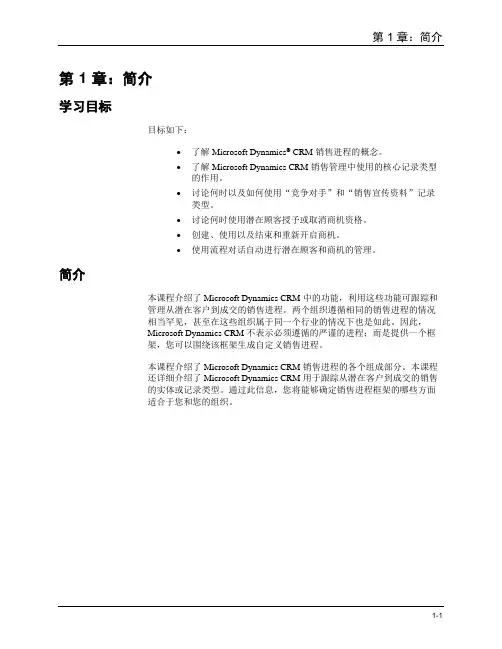
第 1 章:简介学习目标目标如下:∙了解 Microsoft Dynamics® CRM 销售进程的概念。
∙了解 Microsoft Dynamics CRM 销售管理中使用的核心记录类型的作用。
∙讨论何时以及如何使用“竞争对手”和“销售宣传资料”记录类型。
∙讨论何时使用潜在顾客授予或取消商机资格。
∙创建、使用以及结束和重新开启商机。
∙使用流程对话自动进行潜在顾客和商机的管理。
简介本课程介绍了 Microsoft Dynamics CRM 中的功能,利用这些功能可跟踪和管理从潜在客户到成交的销售进程。
两个组织遵循相同的销售进程的情况相当罕见,甚至在这些组织属于同一个行业的情况下也是如此。
因此,Microsoft Dynamics CRM 不表示必须遵循的严谨的进程;而是提供一个框架,您可以围绕该框架生成自定义销售进程。
本课程介绍了 Microsoft Dynamics CRM 销售进程的各个组成部分。
本课程还详细介绍了 Microsoft Dynamics CRM 用于跟踪从潜在客户到成交的销售的实体或记录类型。
通过此信息,您将能够确定销售进程框架的哪些方面适合于您和您的组织。
Microsoft Dynamics CRM 中的销售进程概述本课程将介绍基本销售进程以及不同组织间销售进程的差异。
本课程针对使用哪些销售区域以及如何使用这些区域进行了说明,并为做出相关决策提供了指导。
本课程还介绍了在计划您的组织将如何在系统中实施其销售进程时要考虑的一些最重要问题,并且还提供了若干示例以便说明如何对其进行改编以便适合不同的行业。
什么是销售进程?销售进程是完成某个销售所需的一系列步骤。
此进程从您了解到潜在销售的那一时刻开始,包括从该时间点直到完成销售所经历的每个交互和步骤。
销售进程中的步骤数目、您执行这些步骤所进行的交互的类型以及完成该进程所用的时间量依赖于您的业务和客户。
∙许多销售进程比较简短;例如,在“企业到客户 (B2C)”销售中,客户进入商店,找到所需物品,向销售代表询问问题,然后为该物品付款。
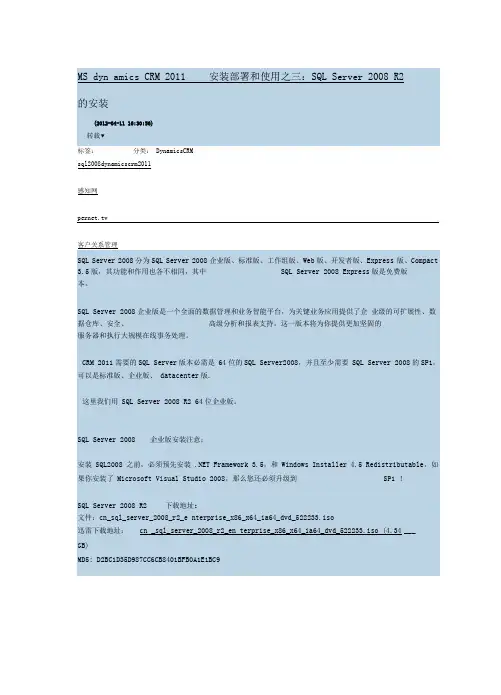
标签:分类: DynamicsCRM sql2008dynamicscrm2011感知网客户关系管理说明:选择光盘中的setup.exe,安装过程中,如果提示错误:并非所有被引用的特权或组都分配给呼叫方。
无论重试或取消都无法退岀请选择,setup.exe,右键--以管理员身份运行1 )运行安装程序,选择安装”- >'全新SQL Server 独立安装或向现有安装添加功能”如下图所示。
WC]tf2)安装程序向导经过系统检测” 产品密钥”、许可条款”三个页面,进入安装程序支持文件”页面,点击安装”进行支持文件的安装过程。
序列号:请向微软购买。
IS^SQt- Se ™rZftOfl E2 SSSS安装程序支持文件单击“妄装”以安装宣装理陣吏持文件。
若要宣装或壷新SQL騒艸并2008 R2,这些交件昱必霁的*衣品密翩许可条隸妄裝稈序支倉文件1功能名称状态妄裝程摩壹持文件SQL灵皿安装程帛霧要下列组件(门.^SqL 畀”“ 2 DOB3 )支持文件安装完后, 进入 规则检查”页面,安装程序会给出几个警告,包括计算机域控制器”防火墙”。
安裝觀序支持规則曳厦观障雯押顾冋誓皋羟莫SfSL Servr 竟荚理隼隶舟文俘时司託烁生的同盘"也质更正皈稱刻A 去報里匡惟曲存里鶴邑 砂能送择魔妥空Itt-wrr 擋渓报吿 K 圭丙;贯镂71|赛義避贋 冗居B )Windows 防火墙只是提示打开防火墙端口。
后面处理点击下一步”,选择“ SQL Server 功能安装甘曲对SUL S?r^r ;主卅襄【飴勺一抉性短匹<计)t 机博时JS ______________曲Hlcrirsirft .HET 盅用1?斥芟全性..Yinl!山M E 蘭火J 間Ld 。
9叨门乩口仞竹+^ri/Li/1勺处归53 c.A )计算机域控制器建议不要将 SQL Server 2008安装在域控制器上。
我们安装1台服务器上,忽略4)在功能选择”页面,勾选 数据库引擎服务”、全文检索”、“ Reporting Service 、”“ Busi ness In tellige nee Developme nt Studio 、管理工具一基本”、管理工具一完整”这几个功能。
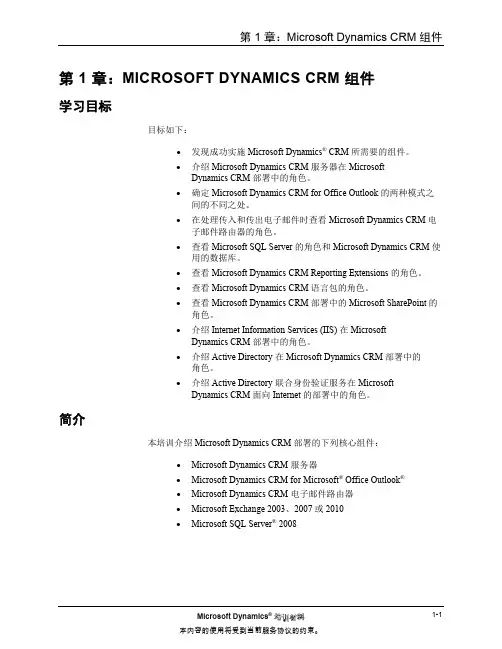
Microsoft Dynamics CRM 2011提高了Microsoft Dynamics CRM 联机版与Microsoft Office Outlook 的集成度。
它完全发挥了本机Outlook 的功能,例如预览和条件格式,并在Outlook 邮件文件夹中显示Microsoft Dynamics CRM 联机区域。
除少数个例之外,这些位于Outlook 中的Microsoft Dynamics CRM 联机区域含有与客户端同样的功能。
更好的Office Outlook 体验若您的组织使用Microsoft SharePoint Server 2010,您能够轻松管理与特定单位中的记录相关的文档。
将Windows SharePoint 作为您的文档存放处,Microsoft Dynamics CRM 2011中的无缝接口允许您快速添加和编辑与特定记录关联的文档。
当您设置文档管理时,Microsoft Dynamics CRM 联机版您的Windows SharePoint 站点上适用于各单位的结构和您所需用来管理文件的记录。
. 语境文档管理Microsoft Dynamics CRM 2011让您能够定义关键业绩和业务健康指标。
通过这种方式,您可以根据贵组织的目标和度量来追踪并衡量结果。
您可以轻松快捷的为一个活动季度或财政期间设置目标。
将小目标,如团队目标和领域目标,与公司的大目标相结合。
将所有的目标按实数创建为数据卷起形式,以显示您追踪数据的模式。
目标管理Microsoft Dynamics CRM 2011通过添加交互式对话框扩展其工作流程能力。
对话为您的客户显示一条连续的信息。
同时,在整个过程中,会话通过逐步指导用户来收集并处理信息。
在一个层面上,您可以使用对话指导客户互动和内部流程。
从另一层面上,通过合成工作流逻辑,您可以提高对话性能,增加对话多样性。
该工作流逻辑通过使用对话过程中客户或用户所作回应来激活自动化任务。
MS dynamics CRM 2011安装部署和使用之十二:与outlook集成(2012-04-25 00:33:23)转载▼标签:分类:DynamicsCRMcrmdynamicscrm2011客户关系管理感知网it与outlook集成,可以让你收发的客户邮件,自动进入到CRM 系统中你与该客户的活动中,对于整体把握客户信息,辅助决策,非常方便。
在windows 下安装CRM for outlook,发现很是费了一番周折。
这主要是CRM for outlook 有过多的安装依赖,包括XP 要求SP3,Office 2003要求SP3 ,还要在本地安装SQL Server 。
windows 7 也是一样。
做了些实验,将经验总结如下。
CRM for outlook 安装步骤1:系统更新:XP,需要安装windows SP3:下载地址:/downloads/zh-cn/details.aspx?familyid=5b33b5a8-5e76-401f-be08-1e1 555d4f3d4我的xp sp3升级后,重启xp启动画面完成后,一直黑屏,仅有鼠标可以动。
等了10分钟后,强行关机,在重启,OK了win7:需要安装SP1步骤2:office更新Microsoft Office 2003 SP3下载地址:/downloads/zh-cn/details.aspx?familyid=e25b7049-3e13-433b-b9d2-5e3c1132f206*2007 Microsoft Office system SP2/downloads/zh-cn/details.aspx?familyid=b444bf18-79ea-46c6-8a81-9db 49b4ab6e5Office 2010无需更新Microsoft Office XP 和Microsoft Outlook 2000 版本不支持步骤3:360更新注意:由于crm for outlook 安装的组件多,未避免安装失败,在以上更新后,win7和xp都要用360更新全部的:1)系统高危补丁2)其他及功能性更新补丁步骤4:CRM for outlook 安装下载地址:/downloads/zh-cn/details.aspx?FamilyID=E35D4E28-CA80-495 0-BB93-61DEA69D7993选择:CRM2011-Client-CHS-i386.exe双击安装( 或进入解压目录,执行”SetupClient.exe“进行安装)安装类型,选择“自定义安装”访问类型,勾选”脱机功能“会自动下载必要的安装组件碰到问题1:XP下SQL 2008 Express始终安装失败。
微软DynamicsCRM自定义实体配置Dynamics CRM自定义实体配置作者: HAND创建日期: 2021-01-06最后更新: 2021-01-06操纵码:版本: 1.0审批签字:客户项目负责人Copy Number _____文档操纵修改记录日期作者版本修改参考2021-01-06 刘崇斌 1.0批阅姓名职位分发拷贝. 姓名地点1111名目新建自定义实体 (4)创建或编辑实体字段 (9)编辑实体的主窗体 (14)创建或编辑实体的公共视图 (24)添加或编辑字段和表单的事件脚本 (30)添加或编辑表单 Web 资源 (30)为表单事件添加事件处理程序 (32)为字段事件添加事件处理程序 (36)未解决的问题 (41)新建自定义实体1.在导航窗格中,单击〝设置〞。
2.在〝自定义〞下,单击〝自定义项〞。
3.在〝自定义〞区域中,单击〝自定义系统〞。
4.单击〝实体〞。
在〝操作〞工具栏上,单击〝新建〞按钮。
5.定义将在 Microsoft Dynamics CRM 中用于此实体的〝显示名称〞和〝复数名称〞。
6.在〝所有权〞列表中,选择其中一项:•用户或团队此实体的记录能够由个人用户或团队负责。
能够依照当前负责人所关联的业务部门来定义安全性。
例如,联系人记录设置为〝用户或团队〞。
•组织此实体的记录用于供所有 Microsoft Dynamics CRM 用户引用。
个人用户或团队无法负责这些记录。
例如,产品记录设置为〝组织〞。
7.在〝名称〞框中,查看 Microsoft Dynamics CRM 将用于此实体的名称。
默认输入内容是使用您在〝显示名称〞中输入的内容创建的。
您能够在储存实体之前修改该名称。
8.在〝显示此实体的区域〞区域中,选择期望在 Microsoft Dynamics CRM 用户界面中显示实体的导航窗格区域。
所有新实体都显示在〝高级查找〞中。
9.在〝实体选项〞区域中,能够选择下表中列出的选项。
MS dynamics CRM 2011安装部署和使用之六:基于声明的验证的知识(2012-04-11 22:43:03转载▼标签:分类:DynamicsCRMcrmdynamicscrm2011客户关系管理感知网it这个部分的内容,可以跳过。
但如果你想对CRM 2011的认证机制和下面的部署,希望有些基本的认识,请阅读此章节。
本章节内容来源:CRM 中文技术支持部博客/b/crmchina/archive/2011/04/22/3423583.aspx 概念概念定义Active Directory Federation Services (AD FS活动目录联合认证服务作为Windows Server 2003 R2 和windows server 2008的一个组件,它支持身份验证联合,web的基于网络浏览的应用程序的单点登录Claim 声明一种区别一个主体和其他主体的陈述信息。
比如这种陈述信息可以是用户名,用户身份,键,组,权限或者能力。
每个声明都是由提供者去颁布的,而这些声明通常都包含一个或者多个值。
Claim rule 声明规则声明规则是使用ADFS2.0里的声明语言编写的。
这些声明语言是用户生成,转换,传递或者过滤声明。
Claims-aware application支持声明的应用程序是可以利用声明去管理用户的身份验证和访问的应用程序。
在这篇文档中,CRM就是支持声明的应用程序。
支持声明的应用程序Claims provider 声明提供者联合服务是为一个特定的事务颁发声明的,在CRM 2011基于声明的认证方式中,ADFS 2.0为它的用户颁发声明。
Federation server 联合认证服务器是已经安装并配置了ADFS 2.0 的Windows 2008 或R2的机器,作为联合认证服务器,它颁布并认证token。
Federation Service联合认证服务一个安全token服务比如ADFS2.0的逻辑实例.Identity provider 身份验证提供者身份验证提供者是用于管理被信任的声明和SAML token。
Microsoft Dynamics CRM®*WCF AdapterforMicrosoft BizTalk Server®User manualPublished on: April 2015* For Microsoft Dynamics CRM 2011, 2013 and 2015© 2015 Rödl Consulting AG. All rights reservedMS-CRM Adapter for Microsoft BizTalk Server®Table of ContentsIntroduction (3)Adapter mode of operation (3)Why an adapter when Microsoft Dynamics CRM provides a WCF interface? (3)Security (7)Configuration of the R&P MS CRM WCF Adapter for MS BizTalk (8)Installation (8)Working with the R&P MS CRM WCF Adapter for MS BizTalk (9)Working with the adapter in Visual Studio 2010 (Designtime) (9)Example: Call a CRM entity and process the response (20)Prerequisites (Runtime) (20)Step 1: Creating the receive port “Account“ (21)Step 2: Creating the send port “Account“ (23)Step 3: Cre ating the schema for ...Account“. (24)Step 4: Creating the Orchestration (25)Step 5: Set up the orchestration in the BizTalk Server Administration Console (32)Step 6: Testing the Orchestration (34)Connecting to CRM Online (35)Further examples (37)Create (38)Update (39)Retrieve (40)Delete (42)Fetch (44)New Upsert and Lookup functionalities (46)Upsert (47)Lookup functionality (49)Import Account (51)WCF XRM Adapter Installation under 64 Bit (54)Background (54)Manual Registration Instruction (54)Paste to the 64 bit machine configuration: (54)Supported Functions (28.11.2011) (55)CRM-Methods (55)XRM-Methods (55)Page 2 ©2015 Rödl Consulting AGMS-CRM Adapter for Microsoft BizTalk Server®IntroductionAdapter mode of operationThe R&P MS-CRM WCF Adapter for MS BizTalk provides a seamless connection between the BizTalk Server and Microsoft Dynamics CRM. The adapter must be installed on the BizTalk Server.On the MS CRM server, no further installations are required, because the R&P MS-CRM WCF Adapter for MS BizTalk communicates with Microsoft Dynamics CRM 2013/2015 via the original WCF service.The R&P MS-CRM WCF Adapter for MS BizTalk is designed generically. This means that the adapter doesn’t contain any explicit functionality for processing individual entities or request methods.The advantage of this generic approach is that entities and attributes created in MS CRM can be used, too.No customizing of the MS CRM system needed.Why an adapter when Microsoft Dynamics CRM provides a WCF interface?Unlike earlier versions, Microsoft Dynamics CRM provides a native WCF service you can use directly in the MS BizTalk Server.But dealing with this service is anything but simple.If you create a service reference for this WCF service, you will receive the following entries in your BizTalk solution:©2015 Rödl Consulting AG Page 3MS-CRM Adapter for Microsoft BizTalk Server®Page 4©2015 Rödl Consulting AGNow let’s consider the generated schem a for the entities in BizTalk Server:The schema …Create“ is completely generic and independent from the several entities. The name of the entity to be created has to be entered in the ele ment …LogicalName“. The individual attributes are filled through key/value pairs (e.g. the elements KeyValuePairOfstringstring/key and KeyValuePairOfstringstring/value).Because of this generic approach, the individual attributes of the several entities do not appear obviously. In managed code, such as .Net assemblies, this approach may be useful. So let’s take a look at what is happening when we are trying to map such a schema:Since the individual attributes of an entity are no longer visible, all content from the key/value pairs have to be extracted. The BizTalk developer needs to know all the attributes and has to enter them into the appropriate functoids.When reading from the messages it is still practicable. But if you need to fill the messages with the key/value pairs, the complexity increases significantly.Based on Richard Seroter’s blog , who has dealt extensively with the MS CRM WCF service and how to use it in MS BizTalk, we collected some key points:(more at: /2011/02/10/the-good-bad-and-ugly-of-integrating-dynamics-crm-2011-and-biztalk-server-2010/)MS-CRM Adapter for Microsoft BizTalk Server ®©2015 Rödl Consulting AG Page 51. First you have to create a loop for each attribute (property of an entity) on theKeyValuePairOfstringanyType node, because a node must be created for each field.2. Then the fields can be mapped on the key element.3. When we trying to map the values directly, we will get a serialization exception at runtime, because thedata type of the values is “xsd:anytype” and it is impossible to map values of this data type directly to an attribute. So we have to use a script functoid to convert the values to the appropriated data types.4. The script code looks like this:This procedure is highly inefficient.Therefore, the R&P MS-CRM WCF Adapter for MS BizTalk works just like the R&P MS-CRM WS Adapter for MS BizTalk . Namely, with typed schemas in which the attributes of the several entities are clearly defined and typed as well.Another important aspect is the complete compatibility of the new adapter with the old adapter. If you are going to switch your BizTalk Server integration from Microsoft Dynamics CRM 3.0 or 4.0 to Microsoft Dynamics CRM, you only need to install the new adapter and switch the ports from the old to the new adapter. The solution will run without any restrictions.MS-CRM Adapter for Microsoft BizTalk Server®Page 6©2015 Rödl Consulting AGWhen using the new adapter, a schema of an account may look like this:…Accordingly, the mapping will look like this and not like the mapping created with the original WCF service:Because the data types of the attributes are determined at designtime, no problems occur during serialization at runtime.The R&P MS CRM WCF Adapter for MS BizTalk will only create the schemas that you actually need.You can easily add the schemas to your project in Visual Studio in the same way as you have done in our WS adapter. We will discuss this point later in detail.For each entity a schema will be created which contains only the attributes of the several entities. These individual schemas are well-arranged and fast. Furthermore, the communication with MS CRM has been simplified. There will be no special schemas for request and response required anymore, but everything is focused on the entity you want to work with.MS-CRM Adapter for Microsoft BizTalk Server®Example Account:SecurityThe R&P MS CRM WCF Adapter for MS BizTalk communicates directly with the original Microsoft Dynamics CRM WCF service interface.The same security rules take effect as if you were working with the WCF service itself.©2015 Rödl Consulting AG Page 7MS-CRM Adapter for Microsoft BizTalk Server®Configuration of the R&P MS CRM WCF Adapter for MS BizTalkInstallationWith the distribution of the adapter you will receive an executable installation file.You can choose between the 32bit and the 64bit installation, which depends on the Windows Server you use for your BizTalk integrations.For installing the adapter, administrative rights are necessary.After completing the installation, a new binding for the “WCF-Custom” adapter named “xrmBinding” appear s.Because the adapter is based on the Microsoft xRM Framework and provides Microsoft Dynamics CRM functions as well as Microsoft xRM functions, the binding is called “xrmBinding”.You can use the adapter to, e.g., create, modify or delete OptionSet values and publish customizations.You will even be able to create, modify or delete custom entities and attributes.Page 8 ©2015 Rödl Consulting AGMS-CRM Adapter for Microsoft BizTalk Server ®©2015 Rödl Consulting AG Page 9Working with the R&P MS CRM WCF Adapter for MS BizTalkWorking with the R&P MS CRM WCF Adapter for MS BizTalk is divided into two workspaces. On the one hand send ports will be defined that are physically linked with the adapter. We call this workspace Runtime Customization .On the other hand schemas will be created in Visual Studio, e.g. account schema. These schemas are needed to send and receive messages. We call this workspace Designtime Customization .Working with the adapter in Visual Studio 2010 (Designtime)1. To start the adapter wizard, right-click on your project and select Add and Add Generated Items.MS-CRM Adapter for Microsoft BizTalk Server®Page 10©2015 Rödl Consulting AG2. In the following screen, select Consume Adapter Service and click Add.3. Now choose the binding and click Configure…MS-CRM Adapter for Microsoft BizTalk Server ®©2015 Rödl Consulting AG Page 114. Here, you can enter the configuration for the Microsoft Dynamics CRM system you want to connect with. Onthe tab “Security” you have to enter the credentials which are used to authenticate against Microsoft Dynamics CRM.The Roedl Adapter supports the following authentication model:5. On the tab “URI Properties” the organization, the port, Secure Mode (True=SSL) and the server name have tobe entered.MS-CRM Adapter for Microsoft BizTalk Server®Page 12©2015 Rödl Consulting AG6. On the tab “Binding Properties” y ou can choose some general timeout options and the targetnamespace. In the section licensing you have to enter the license code and license nameyou have received upon your purchase.7. Click Ok to save the configuration and close the window. If you do not wish to define your own targetnamespace, the adapter will use the default target namespace “xrm://Roedl.Adapters.XRM”. Of course, you can make changes to this setting at any time. By clicking , the adapter authenticates against Microsoft Dynamics CRM, collects some further information from the system and finally provides you a set of categories to work with.MS-CRM Adapter for Microsoft BizTalk Server ®©2015 Rödl Consulting AG Page 138. In the treeview, four groups appear- Entities (contains all entities found in the target system, even custom entities) - Misc (special functions such as Fetch)- XRM Operations (all possible WCF operations of the XRM object model, especially metadata operations) - CRM Operations (all possible WCF operations of the CRM object model, such as assign owner) 9. Select the desired entities and functions and add themwith thebutton.10.Click to close the window and generate the chosen schemas.The solution explorer may appear like this if you have selected the Fetch operation and the account entity:MS-CRM Adapter for Microsoft BizTalk Server®Page 14©2015 Rödl Consulting AG11. If other files are added, you may already use the beta version of the adapter. Feel free to delete theunnecessary files. 12. Use the generated file named WcfSendPort_Adaptername_Custom.bindinginfo.xml to easily create andconfigure a send port, without entering the whole configuration in the BizTalk Administration Console again.Attention:In the XSD file of an entity, a schema for the entity itself and the appropriated entity collection will be generated. The name of this collection is a combination of the entity name and the word List . For example, by generating the schemas for the entity “Account ” a XSD file named entity_Account.xsd containing the schemas Account and AccountList will be created. The collection schema will be needed for the Fetch response of the several entities.MS-CRM Adapter for Microsoft BizTalk Server ®©2015 Rödl Consulting AG Page 15Sample schema for an entity (Account):Sample schema for an entity collection (AccountList):MS-CRM Adapter for Microsoft BizTalk Server®Page 16©2015 Rödl Consulting AGSample schema for an XRM function (CreateOptionSet)Sample schema for a CRM function (ConvertQuoteToSalesOrder )MS-CRM Adapter for Microsoft BizTalk Server ®©2015 Rödl Consulting AG Page 17Configuring send ports for the adapter (Runtime)1. When creating the schema in the designtime, an XML file is created and added to your project. Start theBizTalk Server Administration Console und navigate to your application, e.g. …MSCRM_Adapter_Sample “.2. Right-click on Send Ports , select Import and click Binding s…3. A file selection window appearsNavigate to your VS Solution and select the appropriated XML file for the binding configuration.MS-CRM Adapter for Microsoft BizTalk Server®Page 18©2015 Rödl Consulting AGConfirm the import and the send receive port will be created automatically.4. You must enter your credentials again, usually only the password, and the send port to Microsoft DynamicsCRM is almost fully configured.5. Enter the following XML text into the text field in the section SOAP Action Header:Attention:The Upsert statement is a new functionality for much faster development!MS-CRM Adapter for Microsoft BizTalk Server ®©2015 Rödl ConsultingAG Page 196. Enter the License Name you’ve received upon your purchase.7. Enter the License Code you’ve received upon your purchase.8. You should take the default value for “Target Namespace”, because your schemas are already generatedwith this namespace.MS-CRM Adapter for Microsoft BizTalk Server®Page 20©2015 Rödl Consulting AG9. Enter user name and password on the “Credentials” tab. Depending on t he Authentication type it could bethe following: ActiveDirectory, Federation, LiveId or OnlineFederation10. No modifications needed on the tabs “Messages“ and “Import/Export“.11. Now the send port is ready for use.Example: Call a CRM entity and process the responseIn this example, an account record will be created and the response will be saved in an XML file.Unlike the original Microsoft Dynamics CRM WCF service, the adapter always works with entity objects (schemas). For both, request and response.This reduces the effort of the needed schemas and the user does not have to choose which attributes for the several entities are needed.Prerequisites (Runtime)Before starting the implementation of the example, some preparations have to be made: - Create the following folder structure on the BizTalk Server:c:\BizTalk FiledropCreateAccount Request Response- We will need the following informations of the CRM system:o URLo Login credentials o Proxy, if necessaryStep 1: Creating the receive p ort “Account“1. Open the BizTalk Server Administration Console2. Right-click on Receive Ports, select New and click One-way Receive Port….3. Enter CreateAccount in the Name field and click .4. Right-click on the created receive port, select New and click Receive Location… .5. In the following window select File in the field Transport Type.6. Select your BizTalk application instance in the field Receive handler. If you didn’t install a BizTalk Cluster,you can only choose the main instance.7. Select XMLReceive in the field Receive pipeline.8. Click .leave the default values.10. Click .11. On the window Receive Location Properties click .Step 2: Creating the send port “Account“1. In the BizTalk Server Administration Console right-click on Send Ports, select New and click Static One-way Send Port… .2. In the field Name enter CreateAccount.3. Select File in the field Transport Type.4. Click .5. Enter the folder “C:\BizTalk\FileDrop\CreateAccount\Response\” in the field Destination Folder. In the otherfields, leave the default values.6. Click .7. Select XMLTransmit in the field Send Pipeline.8. Click .Step 3: Creating the schema for …Account“1. Open Microsoft Visual Studio .NET2. Create a new BizTalk project named Roedl MSCRM Adapter3. In the Solution Explorer right-click on your BizTalk project, select Add and click Add Generated Items…4. Proceed as described in the section Working with the adapter in Visual Studio 2010 (Designtime)andcreate the schema for the entity Account and the function Fetch (Misc).5. R&P MS CRM WCF Adapter for MS BizTalk will create three files.6. I n the file “entity_Account.xsd”is one schema for the account (Account)and one schema for the accountcollection (AccountList). I n the file “crm_Fetch.xsd”is the schema for the Fetch message in the file “crm_Fetch.xsd”. And an XML file containing the binding configuration for the send port.Step 4: Creating the Orchestration1. Create a new Orchestration named “CreateAccount”.2. In the Orchestration Designer you will need three logical ports (in the Port Surface).∙ A One way Receive Port“rpCreateAccount”.∙ A One Way Send Port“spCreateAccount”.∙ A Request-Response Port“MSCRM_WCF”.3. Right-click on the left Port Surface and choose New Configured Port… .4. In the appearing wizard, click .5. Type in rpAccount in the field Name and click .6. Enter rpAccount_Type in the field Port Type Name. Leave all other settings as they are. Click .7. On the next form no changes are needed. Click .8. Click to finish the wizard.9. Your orchestration may look like this:10. Repeat these steps for the send port.11. While configuring the send port you have to select I´ll always be sending messages on this port in the fieldPort direction of communication.All other information remains the same.12. For the port MSCRM_WCF you have to create a port with multiple so-called operations, namely: Create,Update, Delete, Retrieve, Fetch and Execute.13. Now your orchestration should look like this:14. Select the operation Request of the Create method. In the property section, select the account schema.15. Repeat this for all methods and enter the following schemas:16. Now the port is ready to send the messages to MS CRM.17. Now you need the send and receive shapes in the orchestration. Choose the appropriated shapes from thetoolbox and drag them into the orchestration.18. Now the message for the orchestration will be created.19. Assign the message to the send and receive shapes and connect them with the logical ports. After that, yourorchestration should look like this:MS-CRM Adapter for Microsoft BizTalk Server®20. The orchestration is now ready to be deployed.MS-CRM Adapter for Microsoft BizTalk Server®Step 5: Set up the orchestration in the BizTalk Server Administration Console1. After successful deployment, the BizTalk Server Administration Console should look like this:2. Expand the application node MSCRM_Adapter_Test and click Orchestrations.3. Right-click on the orchestration Create_Account and select Properties…4. As shown in the screenshot above, bind the three physical ports to the virtual ports of the orchestration.MS-CRM Adapter for Microsoft BizTalk Server®5. Connect the orchestration to the host.6. Click .7. Start the orchestration.8. The BizTalk Server is now ready to execute the orchestrationMS-CRM Adapter for Microsoft BizTalk Server®Step 6: Testing the Orchestration1. Copy a XML file with the following structure into the folder C:\...\CreateAccount\Request.Attention:Take care of the namespace. It has to be the same as given in the schema ofAccount!2. The BizTalk Server reads the file and sends the data to the adapter.3. After a short time an XML file will appear in the folder C:\...\CreateAccount\Response. It will be namedsomething like: {DE15B859-B2AD-4B5D-9A46-5A2CDBE2281C}.xml4. The content of this file shows the data of the created account. Some system attributes created by the CRMsystem will appear too.5. The data can now be processed.Advantage:Note that the response message contains all attributes of the entity, even theattributes provided in the request message. You can directly continue to work withthis data.MS-CRM Adapter for Microsoft BizTalk Server®Connecting to CRM OnlineIf you want to connect to CRM Online, please follow the steps 1-3 from“Working with the adapter in Visual Studio (Designtime)” and continue with the steps below.12. On the Security tab you have to enter user name and password.Depending on the Authentication type it could be the following: ActiveDirectory, Federation, LiveId orOnlineFederation4. This account has to have enough rights on the CRM Online system.MS-CRM Adapter for Microsoft BizTalk Server®5. On the URI Properties tab you have to provide system related information.Please make sure that you type in the correct organization name. This is not the prefix of your CRM Online url, but you can find it in CRM Online when you go to Settings -> Customizations -> Developer Resources.It’s the unique name of the organization.Server Name should be for Europe. Secure Mode = True. Port doesn’t matter in this case, the Adapter will use 443 anyway.On the tab “Binding Properties” you can choose some general timeout options and the target namespace.In the section licensing you have to enter the license code and license name you have received upon your purchase.Afterwards you can continue with Step 6 from “Working with the adapter in Visual Studio (Designtime)”and select your entities and messages.MS-CRM Adapter for Microsoft BizTalk Server®Further examplesIn the following, all the methods of the adapter will be presented once more individually in more detail using the Contact entity.1. First create a folder structure for processing the messages. This may look like this:2. In the BizTalk Server Administration Console,create the appropriate receive and send ports asdescribed earlier in this manual.3. Deploy the orchestrations described in the following and bind the logical ports to the physical ports in theBizTalk Server Administration Console. Right-click on the orchestration Contact_Create.4. In the drop down fields, select the appropriate physical ports and confirm with OK.5. Repeat Step 3 and 4 with the orchestrations Delete_Contact, Fetch_Contact, Retrieve_Contact andUpdate_Contact.MS-CRM Adapter for Microsoft BizTalk Server®CreateThe Create method is used to create entity records.1. Create an orchestration looking like this:2. Create an XML message file to create a new record.For example: contact_create.xmlAttention:Take care of the namespace. It has to be the same as given in the schema!3. Copy the file into the input folder of the receive port Contact_Create, e.g. C:\FileDrop\Contact\Create\In.4. After a short while, an XML file will be appear in the output folder of the send port Contact_Create, e.g.C:\FileDrop\Contact\Create\Out. The content should look something like this:5. The CRM system has created the record and provides the contactid. This can be processed directly in theorchestration.MS-CRM Adapter for Microsoft BizTalk Server®UpdateThe method Update is used for updating entity records.1. Create an orchestration looking like this:2. Create an XML message file to update an existing record.For example: contact_update.xmlAttention:Take care of the contactid, so the CRM system can find the desired record.3. Copy the file into the input folder of the receive port Contact_Update, e.g. C:\FileDrop\Contact\Update\In.4. After a short while, an XML file will appear in the output folder of the send port Contact_Update, e.g.C:\FileDrop\Contact\Update\Out. The content should look something like this:5. The CRM system has updated the record and provides the same message as response.MS-CRM Adapter for Microsoft BizTalk Server®RetrieveThe Retrieve method is used for retrieving a single entity record based on the unique identifier.1. Create an orchestration, that looks like this:2. Create an XML message file to retrieve a single record.For example: contact_retrieve.xmlAttention:Take care of the contactid, so the CRM system can find the desired record. Themessage can also contain further attributes, but the adapter will ignore them.3. Copy the file into the input folder of the receive port Contact_Retrieve, e.g. C:\FileDrop\Contact\Retrieve\In.4. After a short while, an XML file will appear in the output folder of the send port Contact_Retrieve, e.g.C:\FileDrop\Contact\Retrieve\Out. The content should look something like this:5. The CRM system has provided the record with all filled attributes and the data could now be processed in theorchestration.DeleteThe Delete method is used for deleting an entity record based on the unique identifier.1. Create an orchestration looking like this:2. Create an XML message file to delete a single record.For example: contact_delete.xmlAttention:Take care of the contactid, so the CRM system can find the desired record. Themessage can also contain further attributes, but the adapter will ignore them.3. Copy the file into the input folder of the receive port Contact_Delete, e.g. C:\FileDrop\Contact\Delete\In.4. After a short while, an XML file will appear in the output folder of the send port Contact_Delete, e.g.C:\FileDrop\Contact\Delete\Out. The content should look something like this:5. The CRM system has deleted the record and provides the complete record data as response. The contactid isnot contained, because the record with this unique identifier doesn’t exist anymore.FetchThe Fetch method is used to search entity records based on several criterias.1. Create a new orchestration looking like this:2. Create an XML message file to search for one or more records.For example: contact_fetch.xmlAttention:Take care of the namespace. It has to be the same as given in the entity schema,except “contact” instead of “fetch”3. Copy the file into the input folder of the receive port Contact_Fetch, e.g. C:\FileDrop\Contact\Fetch\In.4. After a short while, an XML file will appear in the output folder of the send port Contact_Fetch, e.g.C:\FileDrop\Contact\Fetch\Out. The content should look something like this:5. The CRM system has founded some records based on the given criteria and provides these data via theContactList. These contact records may now be transformed to Contact objects.New Upsert and Lookup functionalitiesThe new functionality is running in Microsoft Dynamics CRM and 2013 Systems. For 3013 Systems, we write a special action method, which call al the fetch functions direct on the CRM System.The Adapter recognizes, if the CRM System is a 2011 or a 2013 System. If the CRM System is a 2013 System, the Adapter also recognize, if the Roedl Action Plugin is installed.If the Roedl Action Plugin is installed, all fetch statements for Update and Lookups are running on the CRM Server.For the new functionalities, we need additional information in the schemas.Especialy for that, we create a new Schema type for the adapter.The schema type ist entity CustomAction.This schema includes the entity schema and the roedlUpsert schema.For the UPSERT functionality, this new entity CustomAction have to be send with the adapter.In the virtual send port, we need for that a new action “upsert”.。